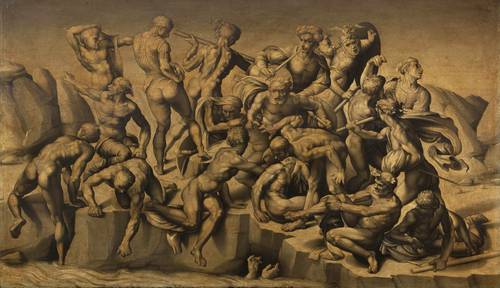Florence. The exhibition Michelangelo, Leonardo, Raphael: Florence, c. 1504, at the Royal Academy of Arts, London, analyzes a crucial period in the history of Florentine art and politics, marked by the expulsion of the Medici and the establishment of the Florentine Republic (1494-1512). During this period, Florence, after overcoming years of instability, attracted the three great masters of the Renaissance thanks to important commissions from a new elite of wool merchants opposed to the Medici.
He David by Michelangelo, who became a republican symbol par excellence as the victor of the Medici tyranny in favor of an oligarchic government with greater citizen participation, after having originally been commissioned for the cathedral of Florence. A commission of politicians and 30 artists was created to decide its location, in January 1504, including Leonardo, who decided to place it at the very entrance of the Palazzo della Signoria, seat of government.
Rafael arrived in October, when he settled; During his Florentine stay, until 1508, he drew the large statue from behind, a work that is included in the exhibition.
The exhibition has the advantage of being relatively small; captures with well-selected works the subtleties of that legendary artistic encounter, with emphasis on Raphael, who, at the beginning of his career, was inspired by the consecrated Leonardo and Michelangelo. Drawing, as a medium, is key to understanding the level of interaction between them, revealing the creative processes of each artist and the versatility of their use.
The creative dialogue
He Tondo Taddei (c. 1504-05), Michelangelo’s masterpiece, illustrates a typical theme of Renaissance Florence: the Virgin with the Child Jesus and Saint John the Baptist, the patron saint of the city exalted by republican patrons in a climate of fervor civic. Its circular format (tondo), Very popular in domestic devotional furniture of the time, it reinforces its contemplative character.
The piece, one of the few Renaissance works in the collection of the Royal Academy, was donated two centuries ago for educational use in the artistic training of its students. Founded in 1768 by King George III, the Royal Academy, the first institution of its kind in the United Kingdom, primarily preserves works by artists associated with it, such as Joshua Reynolds and Turner.
The curators highlight the creative influence of the meeting between the three artists, especially on Raphael, in whom – according to the evidence – neither Michelangelo nor Leonardo were interested, because he was a novice. He studied the Tondo Taddei, which was decisive in its development. This tondo, the most experimental due to the movement of his figures that he decentered, inspired him in more than half a dozen paintings. According to sources, Rafael analyzed this work at the residence of Taddei, who was also his patron and for whom he made two pieces on the same theme.
Among these works, the unfinished Madonna Esterhazy (c. 1508), present in the sample, or in The Bridgewater Virgin (c. 1507-08), from the National Gallery of Scotland, Edinburgh.
Rafael incorporated the dynamic pose of the Baby Jesus of the Tondo Taddei by Michelangelo, softened the interaction between the Virgin and Child, and added personal details. Through sketches he reinterpreted Michelangelo’s ideas and achieved a more intimate and balanced composition in accordance with his style. Drawings present in the exhibition illustrate his working method and aesthetics. Per Rumberg, one of the exhibition’s curators, describes how Raphael explored the dynamics between them by testing postures through improvisation, a method inspired by Da Vinci.
Burlington House Card
The famous drawing by Leonardo da Vinci Burlington House Card, Named in honor of the building that houses the Royal Academy, where it was located until it was sold to the National Gallery, it represents one of its greatest treasures.
This piece is reconsidered in the exhibition under a theory that questions its traditional identification as preparatory to The Virgin with Child and Saint Anne, which is in the Louvre, according to Giorgio Vasari. Due to its finish and the inclusion of Saint John the Baptist, absent in the painting, it is proposed that it is a fragment of an altarpiece never made for the Greater Council Room. This approach relocates its creation between 1506 and 1508, when Leonardo was in Milan, suggesting that it could be the other cartoon cited by Vasari, exhibited in the Basilica of the Santissima Annunziata.
The battles
In the Great Council Room, designed to house a thousand members of the government, murals were commissioned extolling republican power against the Medici. Leonardo started in 1505 Battle of Anghiari (1441), depicting the Florentine victory over Milan. He used an experimental oil painting technique that failed, leaving the work incomplete before he was recalled to Milan in 1506. Decades later, Vasari covered the mural.
In 1504, Michelangelo was commissioned to represent the Battle of Cascina (1364), when Florence subdued Pisa. He only made the cartoons, since in 1505 he was summoned to Rome by Pope Julius II.
Both murals influenced contemporary artists who copied their scenes: the violent flag dispute, by Da Vinci, and Michelangelo’s innovative peaceful moment, with soldiers surprised to be called into battle while bathing in the river.
It is noted that these episodes were only the nucleus of broader compositions, as evidenced by Michelangelo’s drawings of horsemen and soldiers, possibly inspired by Leonardo. Both artists prepared their murals with numerous sketches: by Michelangelo, individual studies of soldiers and a charcoal of the Battle of Cascina, considered one of the most detailed of his career. A drawing by Leonardo, although not directly related to the Batalla de Anghiari, reflects the influence of Michelangelo.
While Leonardo explored facial expressions and the movement of horses to capture the brutality of war, Michelangelo prioritized the heroism of the male body. According to curator Nethersole, Leonardo focused his art on physiognomy, conveying the animality of the conflict, while Michelangelo focused on the human body, exalting its strength and eroticism.
